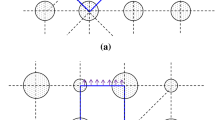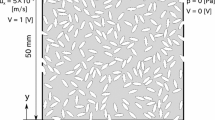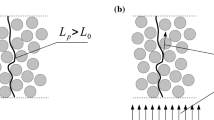Abstract
Tortuosity is an important parameter for characterizing transport properties within porous materials and is of interest in a broad range of fields, such as energy storage and conversion materials. One of the parameters that impacts the tortuosity value is the geometry of the solid phase which, in this study, is considered as stochastically-placed rectangular particles. Through lattice Boltzmann modelling (LBM), we determined the impact of particle aspect ratio on the intrinsic tortuosity–porosity relationships of two-dimensional porous media composed of rectangular particles. These relationships were isolated for materials with grain (particle) aspect ratios of ∈ {1, 2, 3} and porosities from [0.55 – 0.95]. We determined that a minimum of 6, 8 and 10 stochastic simulations, respectively, were required to calculate these average tortuosity values in laminar flow (\( Re \ll 1 \)). This novel application of the LBM to study the effects of porosity and aspect ratio of rectangular grains on tortuosity can be used in the tailoring of materials for clean energy.







Similar content being viewed by others
References
Koponen A, Kataja M, Timonen J (1997) Permeability and effective porosity of porous media. Phys Rev E 56:3319–3325
Thorat IV, Stephenson DE, Zacharias NA et al (2009) Quantifying tortuosity in porous Li-ion battery materials. J Power Sources 188:592–600
Dixit AB, McDougall SR, Sorbie KS et al (1996) Pore scale modelling of wettability effects and their influence of oil recovery. United States: SPE/DOE 10th symposium on improved oil recovery
Oren PE (1994) Pore-scale network modelling of waterflood residual oil recovery by immiscible gas flooding. SPE/DOE Improved Oil Recovery Symposium, Tulsa, Oklahoma, USA
Kang Q, Lichtner PC, Viswanathan HS et al (2010) Pore-scale modeling of reactive transport involved in geologic CO2 sequestration. Trans Porous Med 82:197–213
Nabovati A, Hinebaugh J, Bazylak A et al (2014) Effect of porosity heterogeneity on the permeability and tortuosity of gas diffusion layers in polymer electrolyte membrane fuel cells. J Power Sources 248:83–90
Kapadia S, Anderson WK, Burdyshaw C (2011) Channel shape optimization of solid oxide fuel cells using advanced numerical techniques. Comput Fluids 41:41–50
Bae C, Erdonmez CK, Halloran JW et al (2013) Design of battery electrodes with dual-scale porosity to minimize tortuosity and maximize performance. Adv Mater 25:1254–1258
Zacharias NA, Nevers DR, Skelton C et al (2013) Direct measurements of effective ionic transport in porous Li-ion electrodes. J Electrochem Soc 160:A306–A311
Kehrwald D, Shearing PR, Brandon NP et al (2011) Local tortuosity inhomogeneities in a lithium battery composite electrode. J Electrochem Soc 158:A1393–A1399
Shearing P, Howard L, Jørgensen PS et al (2010) Characterization of the 3-dimensional microstructure of a graphite negative electrode from a Li-ion battery. Electrochem Commun 12:374–377
Hutzenlaub T, Asthana A, Becker J et al (2013) FIB/SEM-based calculation of tortuosity in a porous LiCoO2 cathode for a Li-ion battery. Electrochem Commun 27:77–80
Vijayaraghavan B, Ely DR, Chiang Y et al (2012) An analytical method to determine tortuosity in rechargeable battery electrodes. J Electrochem Soc 159:A548–A552
Chen-Wiegart YK, Liu Z, Faber KT et al (2013) 3D analysis of a LiCoO2–Li (Ni1/3 Mn1/3Co1/3) O2 Li-ion battery positive electrode using X-ray nano-tomography. Electrochem Commun 28:127–130
Chen-Wiegart YK, Shearing P, Yuan Q et al (2012) 3D morphological evolution of Li-ion battery negative electrode LiVO2 during oxidation using X-ray nano-tomography. Electrochem Commun 21:58–61
Goldin GM, Colclasure AM, Wiedemann AH et al (2012) Three-dimensional particle-resolved models of Li-ion batteries to assist the evaluation of empirical parameters in one-dimensional models. Electrochim Acta 64:118–129
Ghanbarian B, Hunt AG, Ewing RP et al (2013) Tortuosity in porous media: a critical review. Soil Sci Soc Am J 77:1461–1477
Sahimi M (1993) Flow phenomena in rocks: from continuum models to fractals, percolation, cellular automata, and simulated annealing. Rev Mod Phys 65:1393
Clennell MB (1997) Tortuosity: a guide through the maze. Geol Soc London Spec Publ 122:299–344
Matyka M, Khalili A, Koza Z (2008) Tortuosity–porosity relation in porous media flow. Phys Rev E 78:026306
Adler PM (1992) Porous media: geometry and transports, 1st edn. Butterworth-Heinemann, Stoneham, MA, USA
Epstein N (1989) On tortuosity and the tortuosity factor in flow and diffusion through porous media. Chem Eng Sci 44:777–779
Duda A, Koza Z, Matyka M (2011) Hydraulic tortuosity in arbitrary porous media flow. Phys Rev E 84:036319
Nabovati A, Sousa ACM (2007) Fluid flow simulation in random porous media at pore level using lattice Boltzmann method. New Trends in Fluid Mechanics Research: Proceeding of the Fifth International Conference on Fluid Mechanics. 518–521
Childs EC (1969) An introduction to the physical basis of soil water phenomena. Wiley, New York
Tindall JA, Kunkel JR, Anderson DE (1999) Unsaturated zone hydrology for scientists and engineers, 1st edn. Prentice Hall, Englewood Cliffs
Wong PZ (1999) Conductivity, permeability, and electrokinetics. Experimental methods in the physical sciences. Elsevier, Amsterdam, pp 119–159
Archie GE (1942) The electrical resistivity log as an aid in determining some reservoir characteristics. Pet Tech 5:54–62
Satterfield CN, Sherwood TK (1963) The role of diffusion in catalysis, 1st edn. Addison-Wesley, Reading
Greenkorn RA (1983) Flow phenomena in porous media: fundamentals and applications in petroleum, water and food production, 1st edn. Marcel Dekker, New York
Shen L, Chen Z (2007) Critical review of the impact of tortuosity on diffusion. Chem Eng Sci 62:3748–3755
Pech D (1984) Etude de la perméabilité de lits compressibles constitués de copeaux de bois partiellement destructurés. Institut polytechnique de Grenoble, Grenoble, France
Comiti J, Renaud M (1989) A new model for determining mean structure parameters of fixed beds from pressure drop measurements: application to beds packed with parallelepipedal particles. Chem Eng Sci 44:1539–1545
Mauret E, Renaud M (1997) Transport phenomena in multi-particle systems—I. Limits of applicability of capillary model in high voidage beds-application to fixed beds of fibers and fluidized beds of spheres. Chem Eng Sci 52:1807–1817
Du Plessis JP, Masliyah JH (1991) Flow through isotropic granular porous media. Trans Porous Media 6:207–221
Ahmadi MM, Mohammadi S, Hayati AN (2011) Analytical derivation of tortuosity and permeability of monosized spheres: a volume averaging approach. Phys Rev E 83:026312
Koponen A, Kataja M, Timonen J (1996) Tortuous flow in porous media. Phys Rev E 54:406–410
Nabovati A, Sousa ACM (2007) Fluid flow simulation in random porous media at pore-level using the lattice Boltzmann method. J Engineer Sci Tech 2:226–237
Pan C, Luo LS, Miller CT (2006) An evaluation of lattice Boltzmann schemes for porous medium flow simulation. Comput Fluids 35:898–909
Schneider K (2005) Numerical simulation of the transient flow behaviour in chemical reactors using a penalisation method. Comput Fluids 34:1223–1238
Hamidi M, Sabbagh-Yazdi SR (2008) Modeling of 2D density-dependent flow and transport in porous media using finite volume method. Comput Fluids 37:1047–1055
Jaffre J (1980) Approximation of a diffusion-convection equation by a mixed finite element method: application to the water flooding problem. Comput Fluids 8:177–188
Ramstad T, Idowu N, Nardi C et al (2012) Relative permeability calculations from two-phase flow simulations directly on digital images of porous rocks. Transp Porous Med 94:487–504
Axner L (2007) High performance computational hemodynamics with the lattice Boltzmann method. University of Amsterdam, Amsterdam
Chen S, Doolen GD (2003) Lattice Boltzmann method for fluid flows. Annu Rev Fluid Mech 30:329–364
Ahrenholz B, Tölke J, Krafczyk M (2006) Lattice-Boltzmann simulations in reconstructed parametrized porous media. Int J Comput Fluid D 20:369–377
Ahrenholz B, Niessner J, Helmig R et al (2011) Pore-scale determination of parameters for macroscale modeling of evaporation processes in porous media. Water Resour Res 47:W07543
Tölke J (2002) Lattice Boltzmann simulations of binary fluid flow through porous media. Philosoph Trans Royal Soc London Ser A: Math Phys Eng Sci 360:535–545
Yablecki J, Hinebaugh J, Bazylak A (2012) Effect of liquid water presence on PEMFC GDL effective thermal conductivity. J Electrochem Soc 159:F805–F809
Yablecki J, Nabovati A, Bazylak A (2012) Modeling the effective thermal conductivity of an anisotropic gas diffusion layer in a polymer electrolyte membrane fuel cell. J Electrochem Soc 159:B647–B653
Sukop MC, Or D (2003) Invasion percolation of single component, multiphase fluids with lattice Boltzmann models. Physica B Conden Matt 338:298–303
Yan YY, Zu YQ, Dong B (2011) LBM, a useful tool for mesoscale modelling of single-phase and multiphase flow. Appl Therm Eng 31:649–655
Gokaltun S, McDaniel D. Multiple-relaxation-time lattice Boltzmann method for multiphase flows with high density and viscosity ratios. Phoenix, AZ, USA: WM2010 Conference; 2010
Huang H, Wang L, Lu X (2011) Evaluation of three lattice Boltzmann models for multiphase flows in porous media. Comput Math Appl 61:3606–3617
Weissberg HL (1963) Effective diffusion coefficient in porous media. J Appl Phys 34:2636–2639
Tsai DS, Strieder W (1986) Effective conductivities of random fiber beds. Chem Eng Commun 40:207–218
Ho F, Striender W (1981) A variational calculation of the effective surface diffusion coefficient and tortuosity. Chem Eng Sci 36:253–258
Barrande M, Bouchet R, Denoyel R (2007) Tortuosity of porous particles. Anal Chem 79:9115–9121
Calmidi V, Mahajan R (2000) Forced convection in high porosity metal foams. J Heat Transfer 122:557–565
Park JK, Lee JS, Lee SI (2002) Preparation of porous cordierite using gelcasting method and its feasibility as a filter. J Porous Mater 9:203–210
Mussa A, Asinari P, Luo LS (2009) Lattice Boltzmann simulations of 2D laminar flows past two tandem cylinders. J Comput Phys 228:983–999
Razzaghian M, Pourtousi M, Darus AN (2012) Simulation of flow in lid driven cavity by MRT and SRT. Thailand: International Conference on Mechanical and Robotics Engineering
Martinez WL, Martinez AR (2007) Computational statistics handbook with MATLAB, 2nd edn. CRC Press, Boca Raton
Dullien FAL (1988) Two-phase flow in porous media. Chem Eng Technol 11:407–424
Succi S (2001) The lattice Boltzmann equation for fluid dynamics and beyond. Oxford University Press, Oxford
Sukop MC, Thorne DT (2006) Lattice Boltzmann modeling: an introduction for geoscientists and engineers. Springer, Berlin
Chen L, Zhang L, Kang Q et al (2015) Nanoscale simulation of shale transport properties using the lattice Boltzmann method: permeability and diffusivity. Sci Rep 5:8089
Nabovati A (2009) Pore level simulation of single and two phase flow in porous media using lattice Boltzmann method. University of New Brunswick, Fredericton, New Brunswick, Canada
Durst F, Ray S, Ünsal B et al (2005) The development lengths of laminar pipe and channel flows. J Fluid Eng 127:1154–1160
Kueny JL, Binder G (1984) Viscous flow over backward facing steps—an experimental investigation. In: Morgan K, Periaux J, Thomasset F (eds) Analysis of laminar flow over a backward facing step. Vieweg + Teubner Verlag, Wiesbaden, Germany, pp 32–47
Acknowledgments
The Thermal Fluids for Advanced Materials (TEAM) laboratory at the University of Toronto is gratefully acknowledged for their support and assistance. The authors would like acknowledge the financial support from Carbon Management Canada Inc. (CMC), Canada Foundation for Innovation (CFI), Natural Sciences and Engineering Research Council of Canada (NSERC), the NSERC Canada Research Chairs Program, and the University of Toronto.
Author information
Authors and Affiliations
Corresponding author
Ethics declarations
Conflict of interest
The authors declare that they have no conflict of interest.
Additional information
SPECIAL TOPIC: Materials for Energy Conversion
About this article
Cite this article
Ebrahimi Khabbazi, A., Hinebaugh, J. & Bazylak, A. Determining the impact of rectangular grain aspect ratio on tortuosity–porosity correlations of two-dimensional stochastically generated porous media. Sci. Bull. 61, 601–611 (2016). https://doi.org/10.1007/s11434-016-1020-3
Received:
Revised:
Accepted:
Published:
Issue Date:
DOI: https://doi.org/10.1007/s11434-016-1020-3




